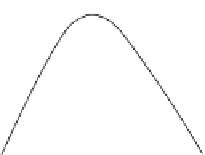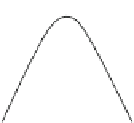Biomedical Engineering Reference
In-Depth Information
Fig. 2
The quadratic
function
V
V
(
T
)
V(T), Condition 2
V(T), Condition 1
1/b
A
B
0
T
C
D>0
D<0
Condition 1 is equivalent to
D
< −
4
b
ε
/
r
2
(
t
)
. Thus,
r
2
(
t
)
V
(
T
)
< −
ε
,
(12)
for all
T
, since the leading coefficient of
V
(
T
)
is negative (i.e.,
−
b
<
0, see Fig.
2
).
The Eq. (
9
) can be written, for every fixed solution
T
(
t
)
, in the form:
T
=
−
δ
T
(
t
)
T
,
(13)
is bounded above by
b
−
1
where
δ
T
(
t
)=
−
r
2
(
t
)
V
(
T
)
/
(
T
+
g
2
)
.Since
T
(
t
)
and
because of Eq. (
12
), the inequality
0 will hold starting from a certain
moment. That completes the proof of the exponential convergence of
T
δ
T
(
t
)
>
δ
0
>
(
t
)
to 0 as
t
→
+
∞
.
Now, let us assume that Eq. (
10
) have two real roots
A
and
B
,
A
<
B
.
The quadratic polynomial function
V
(
T
)
has unique extremum given by
C
=
(
1
−
bg
2
)
2
b
a
(
t
)
e
(
t
)
r
2
(
b
−
1
, corresponding to maximal value of
V
b
−
1
<
(
T
)
.Also,
V
(
)=
−
)
<
t
0. Both roots are negative, i.e.
A
,
B
<
0 if and only if
C
<
0and
V
(
0
)
<
0. We assume
that
r
2
(
t
)
V
(
0
)
< −
ε
for certain positive
ε
. The same arguments of Condition 1 can
be applied.
We note that Conditions 1 and 2 are also necessary for
global
stability of the
state
T
0: if both are not satisfied, it is always possible to choose parameter values
that return a solution for which
T
=
is not converging to 0. As it follows from the
analysis above, key parameters governing the stability of cancer free equilibrium
state
T
(
t
)
=
0 are included in the function:
a
(
t
)
E
(
t
)
(
)=
.
S
t
(14)
r
2
(
t
)
In order to stabilize or completely eliminate the cancer, we suggest the choice
of functions in system (
5
) that force
S
(
)
t
to be uniformly bounded from zero for all














Search WWH ::

Custom Search